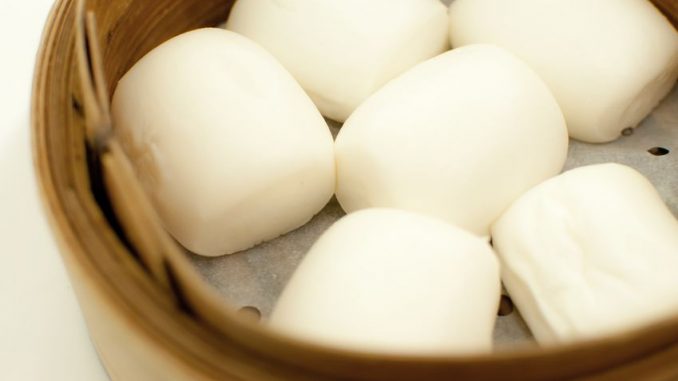
Chinese steam bread or buns are popular staples to accompany all sorts of chinese dishes. Peking duck and chow meins are all popular dishes which often deserve this bread. The Chinese call them ‘mantou’. These buns originated from northern China but are now popular throughout all Asian countries (Wu et al., 2012). There are three types of this bread in China: northern type, southern type (Guangdong), and Taiwan type, based on the shape, volume, sweetness, grain structure and textural characteristics (Hou & Popper, 2006).
The Taiwanese and norther-style breads require flour which has a medium gluten strength. The southern style tends to prefer flours which are less hard having a lower protein content and weak gluten strength. Northern steamed buns tend to be chewy with a resilient texture (Huang et al., 1993; Crobis et al., 1998).
A typical recipe for 24 people is:-
| 1 tbsp active dry yeast |
| 1 tsp sugar |
| 1⁄4 cup all-purpose flour |
| 1⁄4 cup warm water, plus 1/2 cup |
| 1 1⁄2 cup all-purpose flour |
| 1⁄4 tsp salt |
| 2 tbsp sugar |
| 1 tbsp vegetable oil |
| 1⁄2 tsp baking powder |
Preparation time: 30 minutes, Cooks in 15 minutes so ready in 45 minutes
Instruction On Making Them:
- Mix together all the yeast, the flour, 1 teaspoon of sugar, with 1/4 cup of warm water. Allow to stand for 30 minutes.
- Mix in 1/2 cup warm water, 1 1/2 cups flour, salt, 2 tablespoons sugar, and vegetable oil.
- Shape the dough until its surface is smooth, elastic and retains its shape. Add more flour as needed to achieve the desired texture.
- Place in a butter-greased bowl, cover with a tea towel and allow to rise until it triples in size after about 2.5 to 3 hours.
- Start kneading the dough and spread out on a floured board. Sprinkle baking powder evenly on the surface and knead for 5 minutes.
- Divide the dough into 2 parts and place one in a covered bowl. Divide each half into 12 pieces. Shape each into a ball with the smooth surface up.
- Place each ball on a wax paper square. Cover and let stand until doubled, about 30 minutes.
- Bring water to a boil in a wok and reduce the heat to medium where the water should still be boiling. Place a steam-plate on a small wire rack in the middle of the wok. Transfer as many buns on wax paper as will comfortably fit, leaving 1 to 2 inches between each. At least 2 inches of space should be left between the steam-plate and the wok. Cover the wok with the lid.
- Steam buns over boiling water for 15 minutes.
- Remove the lid before turning off the heat, as water will drip back onto the bun surface and produce patches and blisters on the bun surfaces. Continue steaming these batches of buns until all are cooked.
Steamed breads can be stored for about a week at room temperature in colder climates as they are in northern China. However, they are prone to some staling with oxidation of the fats and lipids. Some consumers actually like the slightly aged bread.
References
Crobis, G.B., Huang, S. & Barclay, I.R. (1998). Wheat quality requirement of Asian food. Euphytica, 100, pp. 155–156.
Hou, G. G. & Popper, L. (2006). Chinese steamed bread. In: Future of Flour: A Compendium of Flour Improvement (edited by L. Popper, W. Schafer & W. Freund). Pp. 309–318. Germany: Muhlenchemie GmbH & Co. KG and Agrimedia GmbH.
Huang, S.D., Betker, S., Quail, K. & Moss, R. (1993). An optimized processing procedure by response surface methodology (RSM) for northern‐style Chinese steamed bread. Journal of Cereal Chemistry, 18, pp. 89–102 https://doi.org/10.1006/jcrs.1993.1037
Wu, C., Liu, R.S., Huang, W.N., Rayas-Duarte, P., Wang, F., Yao, Y. (2012). Effect of sourdough fermentation on the quality of Chinese northern‐style steamed bread. Journal of Cereal Science, 56, pp. 127–133 https://doi.org/10.1016/j.jcs.2012.03.007
Leave a Reply